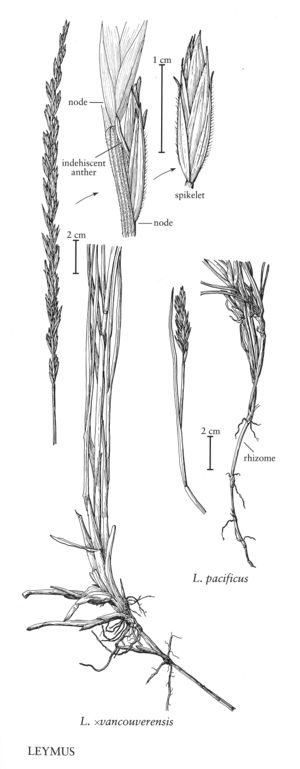Leymus ×vancouverensis
Plants not cespitose, rhizomatous, green or slightly glaucous. Culms 60-122 cm tall, 2-3.5 mm thick, sparsely to densely pubescent below the spike. Leaves exceeded by the spikes; auricles to 1 mm; ligules 0.4-1.2 mm; blades to 9 mm wide, veins promimently rib¬bed, subequal, closely spaced. Spikes 7-32 cm long, 7-11 mm wide, sometimes glaucous, often purplish or green with traces of purple, with 1-2 spikelets per node; internodes 8-12 mm, surfaces hairy distally, hairs 0.1-0.3 mm, edges ciliate, hairs to 1 mm, coarser than the surface hairs. Spikelets 15-20 mm, with 2-6 florets. Glumes 9-28 mm long, 1.5-4 mm wide, lanceolate, glabrous towards the base, pubescent distally, midveins glabrous or with hairs to about 1.3 mm, stiff, keeled or flat proximally, keeled distally, the central portion thicker than the margins, 3 (5) -veined at midlength, tapering from below midlength to an awn, awns to 4 mm; lemmas 8-10 mm, usually completely glabrous, margins and apices sometimes pubescent, apices tapering to an awn, awns to 4 mm; anthers 3.3-7.3 mm, indehiscent. 2n = 28, 42.
Distribution
Calif., Oreg., Wash., B.C.
Discussion
Leymus ×vancouverensis grows at scattered locations on beaches along the Pacific coast, from southern British Columbia to California. It is a sterile hybrid, probably between L. mollis and L. triticoides (Bowden 1957). The northern populations are outside the current range of L. triticoides.
Selected References
None.
Lower Taxa
"decumbent" is not a number."/2-33/4timesthelengthof" is not declared as a valid unit of measurement for this property.
